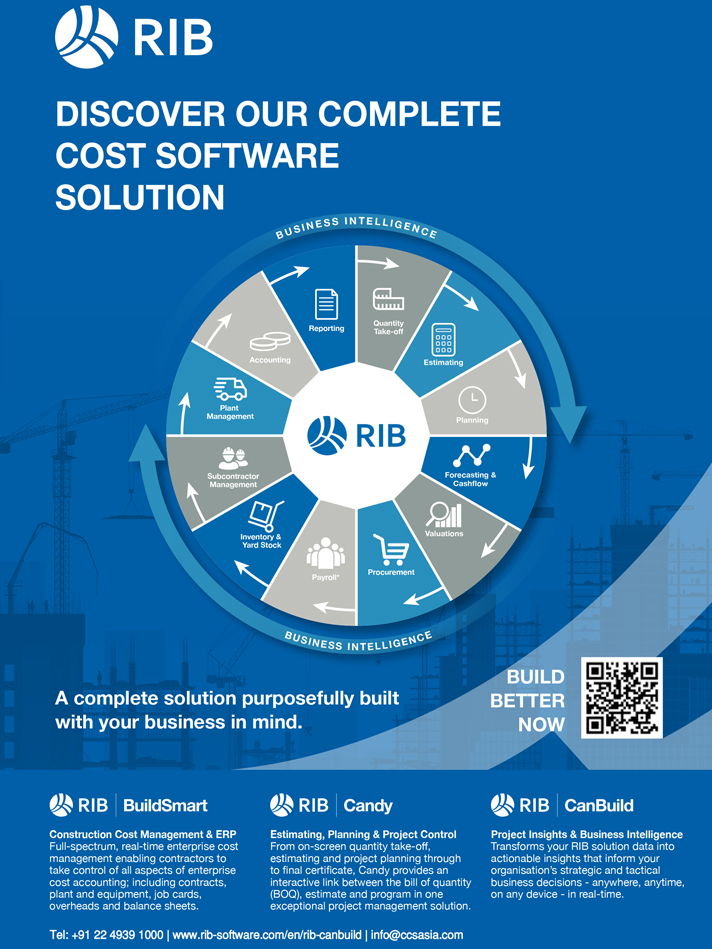
Harmonizing the NEXT PHASE OF CONSTRUCTION
A solid monitoring system and the right technology can go a long way in helping construction companies keep their business on course so that they can ACT quickly when something doesn’t go according to plan. All this requires sound investments into the right construction & project management software and a keen eye on the fast shaping market trends that not only withstand the test of time, but also enable companies in charting their future growth trajectories. We are living in the Digital Era, the faster construction companies come to terms with this fact, the better it is for the whole business environment so that more and more players start embracing the CHANGE that is for the BETTER! Here’s a sneak peek into the fast evolving construction & project management software landscape…writes, PRERNA SHARMA.
For building owners looking to expand their portfolio, trends in construction are warranting increasingly complex builds. In a report by the NAIOP Research Foundation, office building owners who wish to remain competitive in the current market must look to create enlivened spaces with unique and notable amenities. This is true for other markets including retail owners, education facilities, and more. From focusing on common areas to rethinking built-in technology, owners can no longer simply offer a space for chairs, desks, and tables to reside, they must envision a new era of interactive space.
As projects become more complex—physically, commercially, environmentally, and societally—the traditional process of construction is struggling to deliver acceptable outcomes. These traditional processes are dominated by pencil and paper, siloed technology, and gaps in communication across the project life cycle. Trends like common data environments, connected construction processes, and a greater thrust on collaboration will enable construction companies to overcome the resource constraints that have defined construction in the past.
This has led to a new trend in construction. Construction companies are recognizing the value of a more active involvement throughout the construction process. They are actively involved in the construction of their buildings from start to end. Companies’ involvement through construction leads to a smoother handoff with better data for operations on day one. In addition, by involving themselves more in construction work, they are able to ensure projects move along on schedule and that work is done right the first time. Ultimately, the best companies understand that their role in construction reduces risk, delays, and costs—setting themselves up for more profitable operations after the handoff for the life of the building.
With companies having increased involvement in the project process, and are demanding improved data sets for future operations, technology is taking centerstage. Real-time collaboration, utilizing cloud-based solutions becomes an integral component of successful builds.
Construction projects are at their best when information flows freely between workers and the job site and stakeholders in the office. Determining an updated schedule for a job, one that compensates for the latest conditions and allows crews to get back on track, is a quicker and more effective process if leadership know what is happening on the job site in real-time. Construction software allows this exchange of information to take place, with workers on the site updating shared files through mobile devices. These personnel have the option of uploading pictures to show the exact status of issues on the site. Construction management software improves communication between employees and helps to increase project productivity by reducing response time. Construction management software adoption is increasing as large-scale development projects take place around the world, which is expected to drive market growth in the future.
Statistics illustrate the need for better efficiency and collaboration: a McKinsey analysis of the global projects database indicates that large projects across asset classes typically take about 20% longer than scheduled to finish—and come out up to 80% over budget.
The pandemic resulted in a considerable number of routine activities and businesses to shift their operations online and made it challenging to work on a building site. The construction industry is collaborative and requires quality and manufacturing control and proper understanding between the various stakeholders engaged in the project. A construction project generally contains various components, including vendors, architects, contractors, engineers, and the workforce. For many years, tablets, drawings, and graphs were utilized to record the information exchange between the involved parties. These factors are expected to boost the construction management software market’s growth.
Capturing the demand pattern
The Global Construction Management Software Market size is expected to reach $16.6 billion by 2028, rising at a market growth of 9.8% CAGR during the forecast period, according to research published by Research & Markets.
The growth is attributed to the rising awareness and the government’s focus on using construction management software. There is a large-scale adoption of digital systems in the infrastructure domain and BIM by engineers, builders, architects, and builders. Hence, the role of the government to increase the software’s utilization due to its higher quality of construction projects joined with digitalization will surge the market growth in the region.
On the basis of deployment mode, the construction management software market is divided into on-premises and cloud. The on-premise segment witnessed the largest revenue share in the construction management software market in 2021. The growth is attributed to the control and flexibility offered by the on-premise deployment to customize the organization’s system software and IT infrastructure and manage data. Also, on-premise servers provide construction firms with an internal network that is accessible at any time without the requirement of a proper internet connection. The control and flexibility joined with other benefits, will drive the segment’s growth in the forecasted period. The increasing complexity of real-time collaboration among project stakeholders, large upfront capital investments, and higher storage requirements are all contributing to segment growth.
Another research by Verified Market Research points out that that Cloud-based technology adoption in management software adds more value to the construction management process, resulting in significant long-term benefits. Long-term benefits include construction professionals becoming aware of the technology and being willing to adopt it. As a result of the increased demand for digitalization in construction projects, the adoption of cloud-based technology is in high demand, fuelling the growth of the global construction management software market.
By building type, the construction management software market is classified into commercial building and residential building. In 2021, the commercial segment recorded a significant revenue share in the construction management software market in 2021. This is because of the rising usage of construction management software for commercial building construction. Also, the rising focus on sustainable development is increasing the preference for green commercial buildings among occupiers and developers both. Hence, the wider utilization of construction-based software and the increasing commercial buildings sector will drive the segment’s growth.
Based on the end user, the construction management software market is bifurcated into architects & designers, construction managers and others. The construction manager segment acquired a remarkable growth rate in the construction management software market in 2021. This is because this software integrates costing, enterprise, and project accounting for live analysis and effective project management. Web-based enterprise management system gives industry-aligned information to construction companies. Construction managers utilize this software to drive efficiency in construction projects through close coordination of the numerous stakeholders involved in the project. Thereby, these characteristics are anticipated to boost the segment’s expansion. The increasing use of BIM by architects enables synchronization of design and construction planning, conflict detection, and visualization, all of which will aid in the planning, design, and management of building projects. Furthermore, the rising demand for design proficiency, to take advantage of project perspectives such as scheduled building, development, and building parameter endorsement, can be attributed to the segment growth.
By application, the construction management software market is classified into project management & scheduling, safety & reporting, project design, field service management, cost accounting and others. The project management & scheduling segment generated the highest revenue share in the construction management software market in 2021. This is due to the increasing requirement to control and manage project activities like allocating resources, tracking project progress, and reducing time delays. Such solutions allow the organization to gain momentum and traction to meet the project objectives within the given time frame. Hence, these features will drive market growth.
Deploying Next Gen Technological Advancements
Implementation of IoT and AI is expected to offer remunerative opportunities. Technological innovation in construction management is not designed to replace professional personnel; it is created and deployed to help complement their processes and procedures, maximizing efficiency and results. Embracing the use and harnessing of the ability of AI and the benefits of the IoT persists in bringing dividends. With innovation, the use of IoT and AI in construction brings the need to ensure that it is technically sound. In terms of the overall market, utilizing AI and IoT in construction management can provide numerous benefits. Apart from this, the growing importance of lean management is also propelling the market.
Key players in this industry are adopting growth strategies that propel the market. For instance, in September 2022, Oracle introduced Construction Intelligence Cloud Analytics, a tool for identifying issues, foreseeing hazards, and guiding future decisions. Oracle Construction Intelligence Cloud analyzes data from across the Smart Construction Platform to help organizations make better decisions across project and asset lifecycles. Oracle Construction Intelligence Cloud Advisor leverages AI and machine learning to deliver predictive intelligence using your historical project data. It continuously identifies hidden risks that need to be investigated and actioned, including schedule delays, poor schedule quality, process inefficiencies, and project-planning issues.
Unlike many tools that only report on historical trends, Construction Intelligence Cloud Advisor is focused on predicting future outcomes and preventing adverse events from impacting successful project delivery across your portfolio. With patent-pending AI algorithms and built-in machine learning mechanisms, the tool learns over time to provide insights that are customized to your projects and organization.
Autodesk, Inc. recently announced a suite of new capabilities across Autodesk Construction Cloud, making it easier for construction project teams to use and maximize the value of BIM from the office to the field. The enhancements provide all stakeholders with immediate access to model data and information that’s relevant, empowering team members to simplify workflows and make critical decisions faster. Alongside significant advancements were also announced to Schedule and Cost Management capabilities within Autodesk Build, the comprehensive construction management and field collaboration solution of Autodesk Construction Cloud, aimed at helping customers deliver construction projects on time and on budget.
“To stay in command of increasingly complex and demanding construction projects, we need to ensure teams can work from the latest information and quickly make informed decisions,” said James Mize, VDC and Digital Delivery Specialist at CRB Group. “The model is a great source of truth during design and planning, but data isn’t easily transferred to construction teams during the build phase of a project. With the new model-based capabilities added to Autodesk Construction Cloud, we can use live Revit data to create assets, tie model properties directly to the assets, and view all the information we need in either 2D or 3D. We’re now able to take full advantage of model data to save time across all projects, minimize miscommunication and make smarter business decisions.”
In yet another interesting development, Autodesk unveiled the first set of capabilities of Autodesk Forma, an industry cloud that will unify workflows across the teams that design, build and operate the built environment. Forma’s initial capabilities target the early-stage planning and design process with automations and AI-powered insights that simplify exploration of design concepts, offload repetitive tasks, and help evaluate environmental qualities surrounding a building site, giving architects time to focus on creative solutions. This release marks the first step for the architecture, engineering, construction, and operations industry cloud, as new features and capabilities will be added to Forma on a continual basis. In the complex construction environment, where myriad interdependent tasks require quick approval to keep everything moving, one missed approval can stop a project in its tracks. That can be very costly in terms of delays and dollars lost, as well as potential fines and lost incentives. When workflow processes are paper-based, the likelihood of a missed or delayed approval increases exponentially.
Companies can reduce risks with real-time visibility into approval workflows. e-Builder Enterprise features a fully integrated, automated, cloud-based scheduling system that integrates project management and scheduling. It links scheduling with internal systems such as finance and lets companies import data from other solutions, giving them an owner-centric scheduling too for managing milestones. It offers full transparency and visibility for better planning and decision-making across projects. e-Builder Enterprise creates standardized approval processes with integrated features such as automated approval workflows. It offers built-in verification tools and electronic signatures, which reduces the risk of a missed approval and shortens the approval cycle time.
Procore’s newest product, Workforce Planning, creates a single source of truth for contractors to manage their most important asset — their people. Unlike spreadsheets, whiteboards, or in-house-built solutions, Workforce Planning centralizes scheduling and communication with real-time insight into a workforce’s availability and skill set. It also uses historical data to understand what resources are needed from one job to the next and integrates with human resources and enterprise resource planning systems.
TIMES ARE A CHANGING!
Digital technologies are changing how companies operate and do business. Many advanced companies are pushing forward into new technological realms. Many in the construction industry are just beginning to set up a digital strategy, moving off paper, and enhancing team collaboration. Some have already digitized and now want to reap the full benefits of technology by breaking down data silos to integrate business processes and automate manual workflows. Others have been on this journey for a while and are ready to optimize data to synthesize powerful insights and seize opportunities that come with the convergence of manufacturing and construction.
The importance of connection will continue to increase as the construction industry evolves in step with technology. More progress has been made in construction in the last twenty years than the preceding two hundred. With that progress in mind, it’s even more important that owners choose solutions that keep them connected.
Complex new building starts are going to come with a whole new list of requirements. Digital business practices are no longer a nice-to-have; they are a business necessity. The ability to have connected, intelligent, and accessible data will determine future success for owners, and this is where construction & project management software will find their mainstay.
Fast Facts
- Construction management software is used to create, manage, and execute an effective construction management plan. It offers end users effective construction planning that defines the project’s goals, scope, and budget.
- Construction management software reduces construction project costs. It is beneficial to home builders, remodelers, specialty contractors, and general contractors.
- The global construction management software market is expected to expand rapidly in the future owing to an increase in demand for construction management software among end-users.
- The increasing use of BIM by architects enables synchronization of design and construction planning, conflict detection, and visualization, all of which will aid in the planning, design, and management of building projects.














